Cacio e pepe (cheese and pepper) is a super simple Roman dish that can be a challenge, but our step by step photos will show you how to make one of the most comforting Italian pasta dishes with confidence. The best part about making this classic is the more you practice, the better you’ll get. Get ready to carbo-load for this one!
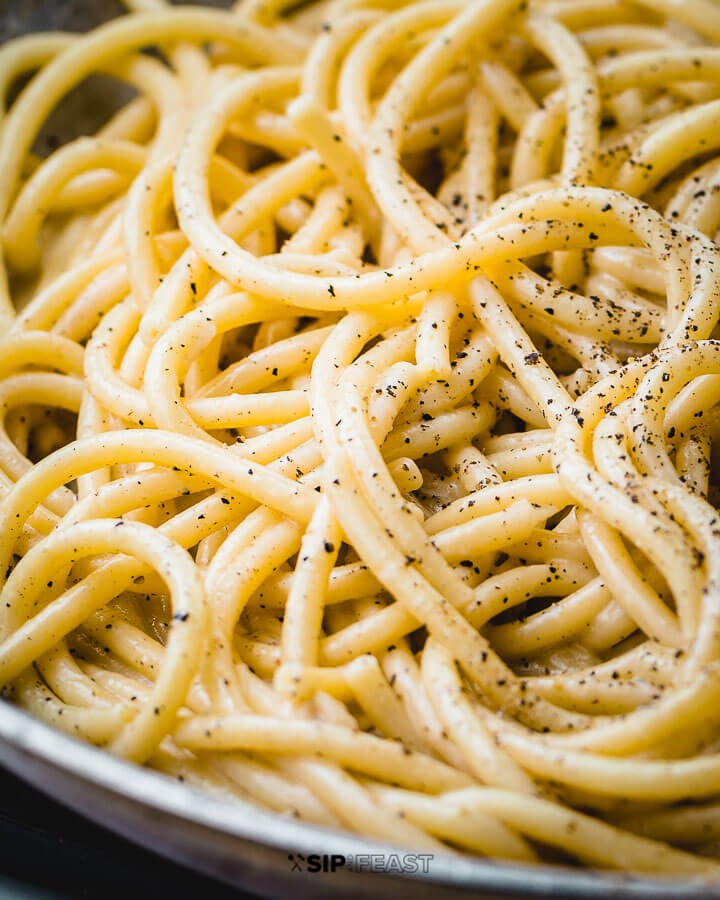
Want To Save This Recipe?
This post may contain affiliate links. Our disclosure policy.
When we make bucatini cacio e pepe, one of the traditional Roman pastas, we often gather around the kitchen island and eat it right away before the pasta dries out and the creamy consistency is lost.
This is not a dish to order out, bring home leftovers, and microwave the next day.
Like the other Roman pastas (Carbonara, Amatriciana, alla Gricia, and pasta alla Zozzona) Cacio e Pepe is meant to be enjoyed, and devoured immediately!
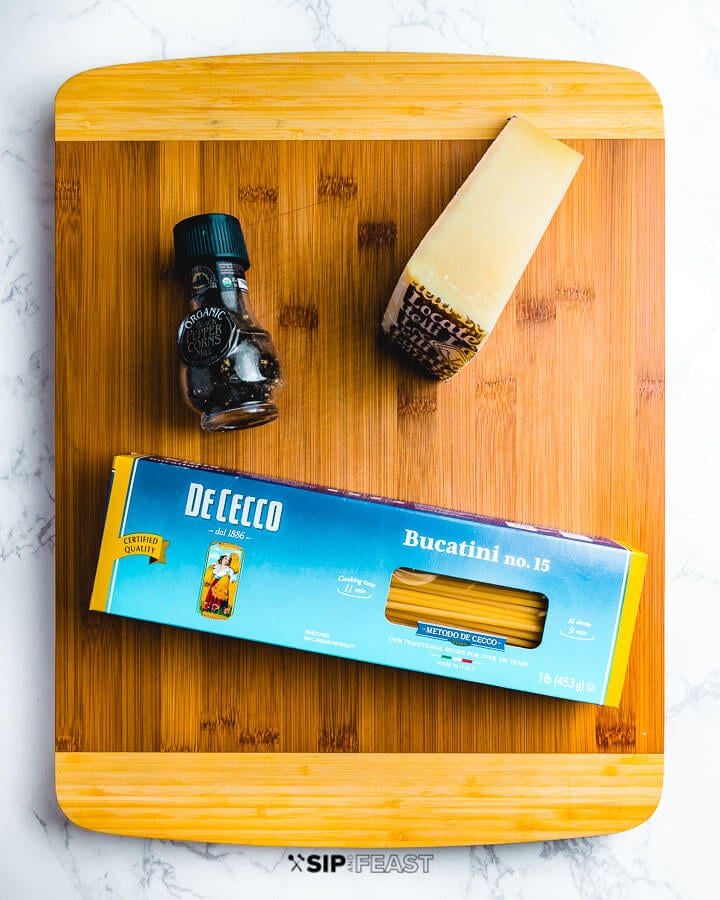
Step by step process
- Cook 1 pound of bucatini until ‘al dente’ in salted water, reserving the pasta water. Tip – Use less water to boil than usual to achieve starchier water. This will help in making the sauce creamier. Begin by grating 2 cups of Pecorino Romano cheese on the finest setting. Alternatively, use pre-grated fine Pecorino Romano.
- Heat a large pan on medium heat with 1 Tbsp of olive oil. Add 2 teaspoons of coarse black pepper to the oil and cook for 1-2 minutes until fragrant.
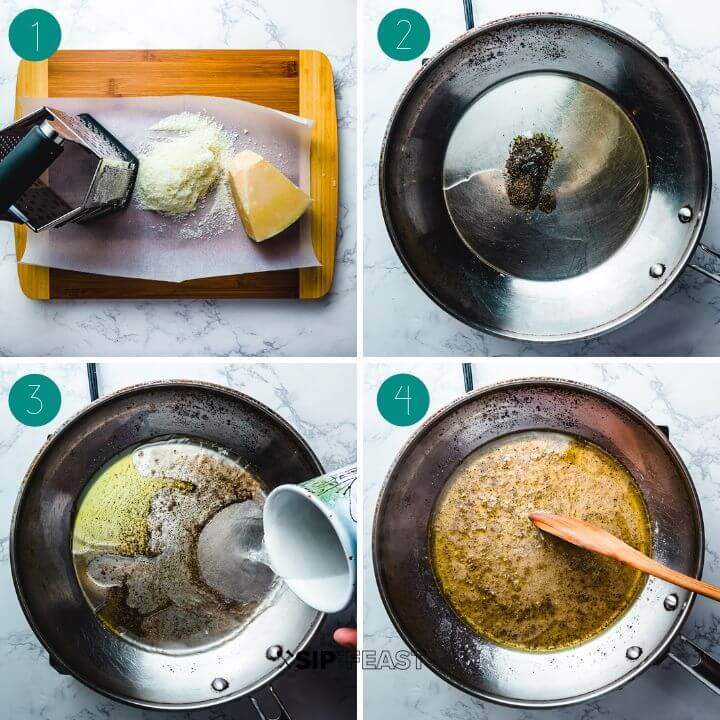
- Add 1 cup of the reserved starchy pasta water.
- Let it cook for a minute.
- Add the pasta to the pan and toss to coat. Turn off the heat.
- Slowly add 1 1/2 cups of Pecorino Romano and start stirring immediately with a wooden spoon.
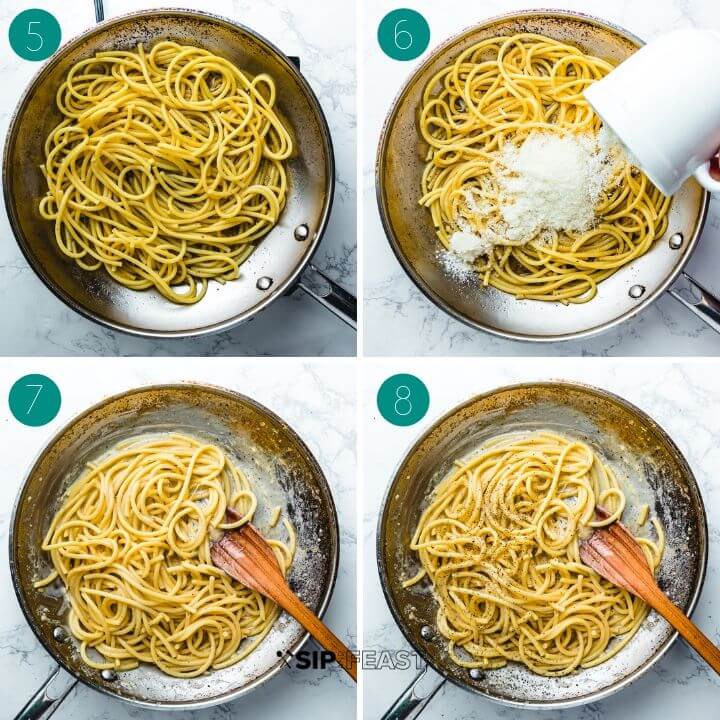
- Keep stirring until the cacio e pepe is real creamy and the cheese is melted smooth. Add 1-2 tablespoons of extra cooled-down pasta water at a time to loosen the sauce up if required.
- Hit the pasta up with a touch more pepper, taste test and adjust salt if necessary. Plate immediately and serve with more pepper and Pecorino Romano.
Top tips
- Turn off the heat after adding the pasta to the pan. This will slightly cool the temp prior to adding the cheese, making it more likely for the cheese to not clump up.
- Make sure to grate the cheese really fine, or buy pre-grated ultra-fine Pecorino. This will help it melt more quickly.
- Using a touch of oil helps the sauce emulsify. Some people use butter as well for this step. Neither are traditional and might trigger the authenticity police – you’ve been warned!
- Stir quickly with a wooden spoon as soon as the cheese hits the pasta. If you have help, have one person slowly add the cheese in while you mix quickly.
- If the pasta is too dry add 1-2 tablespoons of pasta water at a time to bring the creamy consistency right back to the bucatini cacio e pepe.
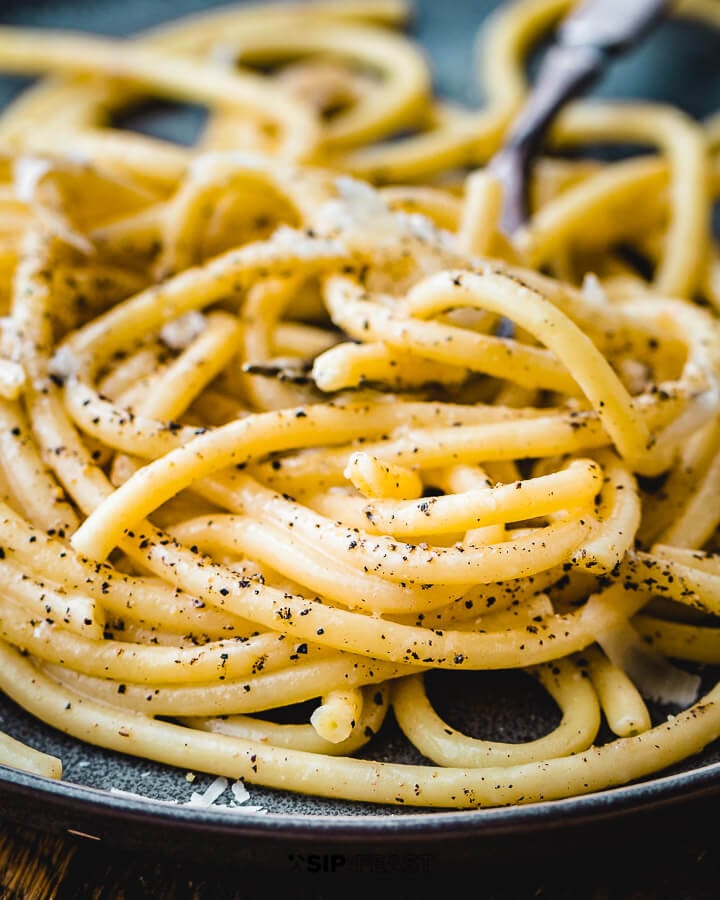
More creamy pasta recipes
If you’ve enjoyed this Bucatini Cacio e Pepe Recipe, give it a 5-star rating.
Watch us on YouTube, follow along on our Facebook Page, and become a Patreon member to receive access to exclusive full-meal videos and content.
Bucatini Cacio E Pepe
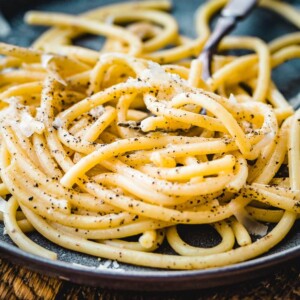
Ingredients
- 1 pound bucatini pasta
- 2 cups Pecorino Romano
- 2 tsp black pepper
- 1 Tbsp olive oil
Want To Save This Recipe?
Instructions
- Cook bucatini until 'al dente' in salted water. Reserve at least 1 cup of pasta water.
- Grate 1 1/2 cups of Pecorino Romano cheese.
- Heat a large pan on medium heat and cook 3 tsp of pepper in 1 Tbsp of olive oil for 1-2 minutes. Add 1 cup of pasta water to the pan and cook for 1 more minute.
- Add the bucatini to the pan and stir to coat. After 1 minute of cooking, turn off the heat to the pan.
- Add the cheese slowly and stir to combine. Mix in a fast motion to create a creamy sauce that thoroughly coats the pasta. If too dry add 1 Tbsp of pasta water at a time to create the perfect creamy consistency.
- Taste test and adjust salt if required. Serve immediately with more pepper and Pecorino Romano. Enjoy!
Notes
- Turn off the heat after adding the pasta to the pan. This will slightly cool the temp prior to adding the cheese, making it more likely for the cheese to not clump up.
- Make sure to grate the cheese really fine, or buy pre-grated ultra fine Pecorino. This will help it melt more quickly.
- Using a touch of oil helps the sauce emulsify. Some people use butter as well for this step.
- Stir quickly with a wooden spoon as soon as the cheese hits the pasta. If you have help, have one person slowly add the cheese in while you mix quickly.
- If the pasta is too dry add 1-2 tablespoons of pasta water at a time to bring the creamy consistency right back to the bucatini cacio e pepe.
- If all else fails, ( You might have to make a couple of attempts. This is part of the fun and joy of learning to cook!) use the bowl method where the cheese, pasta water and pepper are combined into a paste before adding the pasta back in.
- Leftovers are not recommended due to sauce separation.
Nutrition
Nutrition information is automatically calculated, so should only be used as an approximation.
Follow Me







Add some Australian mountain pepper for a real special result. Also adds a slight purple hue which is wonderful.
Amazing! So simple and tasty😍
First time and it was perfect. I went by your instructions and it came out great. I didn’t use olive oil. Just went by your video.
Thanks
Anna Atkins
Hello James
I love many of your recipes, and most of all I love the soooo informative comments you make about them. Such as the one about using a noodle other than bucatini. I personally love it,. but my husband likes a noodle that is easier to “spear” on the fork. (sigh…) So I will make it with some other noodle, and I know we will both enjoy it. And… Cent’anni…so that you can make more great recipes for me to try!
Love your recipes James. I also love that you’re from Long Island (like myself) and mention the ingrediants by name and where you get them from.
Keep up the good work my friend and maybe I’ll run into you at Costco one day.
Ciao for now.
Hey Rich, thanks for the comment and we’re so happy you’re enjoying the recipes!
I made your Cacio e Pepe with spaghetti for myself when my wife was out to dinner with friends. When I told her the ingredients, she was reluctant to try it (starchy pasta water?). Later, she tried some leftovers. Now it is the pasta of choice to go with my braciola for company. Thanks Jim
Hey Tony. The starchy pasta water is so important for dishes like traditional cacio e pepe and fettuccine alfredo. The starchy water holds the emulsion and almost acts as cream would. I think serving this with braciole is an excellent choice!
Hey Jim,
Thanks for the videos and recipes.
I found that I could reheat leftovers by bringing about 1/4 cup pasta water to a simmer in a pan and continually stirring the pasta until desired temp, the separated sauce re-combined using that method. I thought you might like the tip.
Keep it up mate.
Hi Daniel. I appreciate the tip. Glad you’re enjoying the videos and recipes.
First off, love the videos. However, I made this one, and one word comes to mind: salty!
The amount of Pecarino Romano called for adds an insane amount of salt to this dish. I would recommend another milder hard cheese as a substitute for the main emulsion, finishing with a dusting of Pecarino Romano. Definitely wouldn’t be the traditional method, though. Just be forewarned.
Hi JB. Pecorino Romano is indeed quite salty. There is really no way to make a low salt real cacio e pepe since the main ingredient is a large amount of Pecorino Romano. Anyway, sorry you didn’t like it, but thanks for liking the videos.
Just made this dish and it’s delicious! As per your video, I opted to leave the olive oil out and everything still melted wonderfully. Paired this with a side of roasted broccoli with cheese and lemon. So so good! Next time, I’m going to experiment with different types of pasta. Thank you for the recipe and looking forward to trying many others. ☺️
PS: love the videos you make. Recipes look very approachable.
Hey there. It’s great to hear that you enjoyed it and thanks for liking the videos!
Made it for the first time. Read many different recipes on Pinterest and talked to a friend living in Rome. She said using butter is an American version of Cacio e Pepe but all Italian food has olive oil in it. That is why I was drawn to this recipe.
Quick easy and delicious!!!
Hi Mary Jane! Butter makes the dish a bit creamier and helps avoid the cheese clumping. But, your friend would of course know that it is not traditionally prepared that way. Thanks for the comment and glad you enjoyed it!